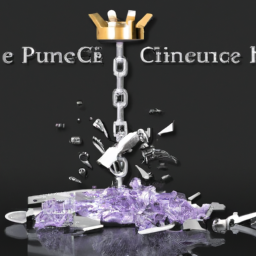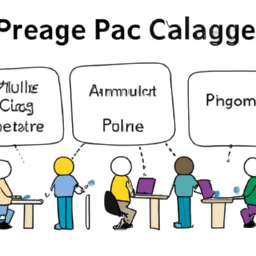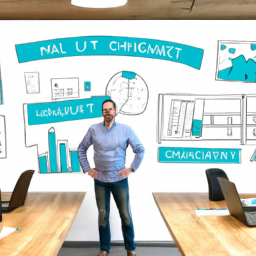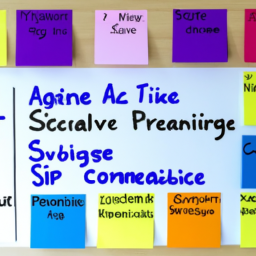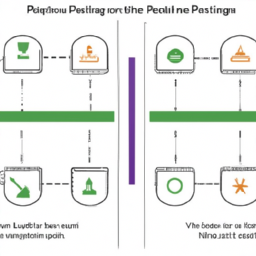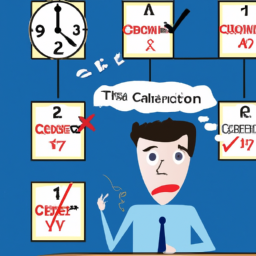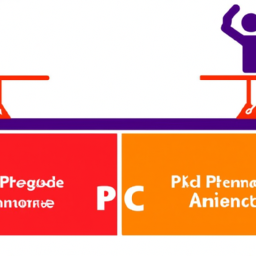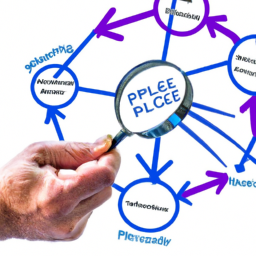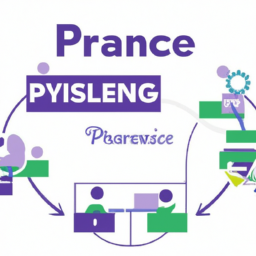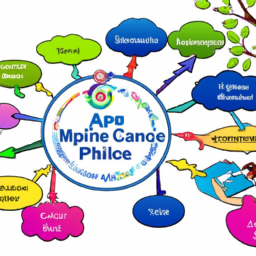Are you preparing for the PRINCE2 Agile exam? Don’t overlook these 7 crucial topics!
- Dive into Agile Principles and Frameworks,
- discover the art of integrating Agile and PRINCE2 methodologies,
- and master stakeholder engagement and communication in Agile projects.
Learn how to effectively manage risk and uncertainty,
- plan and estimate in Agile projects,
- and ensure top-notch Agile product delivery and quality management.
Finally, explore the art of tailoring PRINCE2 for Agile projects.
Don’t miss out on these essential exam topics!
Key Takeaways
- Agile principles align with PRINCE2’s emphasis on customer satisfaction and adaptability.
- Integration of Agile and PRINCE2 methodologies provides benefits like improved flexibility and collaboration.
- Integration improves collaboration by enabling cross-functional teams to work together seamlessly.
- Agile integration ensures faster delivery of project outcomes.
Agile Principles and Frameworks in PRINCE2
Agile principles and frameworks are crucial in PRINCE2 and can’t be overlooked. When it comes to managing projects, PRINCE2 provides a solid foundation. However, incorporating agile principles and frameworks takes it to the next level.
The Agile Manifesto, with its focus on individuals and interactions, customer collaboration, and responding to change, aligns perfectly with PRINCE2’s emphasis on customer satisfaction and adaptability.
Agile frameworks such as Scrum, Kanban, and Lean provide specific methodologies that can be integrated with PRINCE2 to enhance project delivery. By combining the best of both worlds, PRINCE2 Agile promotes flexibility, continuous improvement, and faster delivery of high-quality products.
It enables project managers to embrace change, work collaboratively, and deliver value to stakeholders. Understanding and applying agile principles and frameworks in PRINCE2 is essential for successful project management.
Integrating Agile and PRINCE2 Methodologies
When integrating Agile and PRINCE2 methodologies, you can expect to experience a range of benefits. These include improved project flexibility, increased collaboration, and enhanced adaptability to changing requirements.
To ensure successful implementation, it is important to follow best practices such as aligning project objectives, establishing clear communication channels, and fostering a culture of collaboration. However, it is also crucial to be prepared to overcome challenges, such as resistance to change and conflicting project management approaches, by addressing them proactively and adopting a flexible mindset.
Benefits of Integration
To fully understand the benefits of integration, you should consider how it can enhance collaboration and streamline processes. By combining agile integration with PRINCE2 methodologies, you can achieve a more efficient and effective project management approach.
Here are the advantages of integration:
-
Improved collaboration:
-
Agile integration allows for cross-functional teams to work together seamlessly, promoting better communication and knowledge sharing.
-
PRINCE2 methodologies provide a structured framework that ensures everyone is aligned and working towards the same goals.
-
Streamlined processes:
-
Agile integration enables quick and iterative development cycles, allowing for faster delivery of project outcomes.
-
PRINCE2 methodologies provide a comprehensive set of processes and controls that ensure projects are managed in a structured and organized manner.
Best Practices for Implementation
Implementing integration best practices requires careful planning and coordination to ensure a successful outcome. To effectively implement integration strategies, there are several project success factors that you should consider. These strategies and factors are crucial in achieving a seamless integration process and maximizing the benefits of integration.
Here is a table outlining some key implementation strategies and project success factors:
| Implementation Strategies | Project Success Factors |
|---|---|
| Clear communication | Stakeholder involvement |
| Detailed project plan | Adequate resources |
| Agile project management | Change management |
| Testing and validation | Risk management |
| Continuous monitoring | Performance measurement |
Overcoming Challenges Successfully
Facing challenges during integration can be difficult, but with proper planning and a proactive approach, you can overcome them successfully. Here are some successful strategies to help you overcome challenges:
-
Build a strong team:
-
Ensure that team members have the necessary skills and expertise.
-
Foster open communication and collaboration within the team.
-
Establish clear goals and objectives:
-
Clearly define what needs to be achieved.
-
Break down complex tasks into smaller, manageable steps.
By following these strategies, you can navigate through the challenges of integration more effectively.
However, overcoming challenges is just one aspect of project management. Another critical aspect is stakeholder engagement and communication in agile projects. Transitioning into this topic, it is important to keep stakeholders informed and involved throughout the project lifecycle.
Stakeholder Engagement and Communication in Agile Projects
Effective stakeholder engagement and communication are crucial in agile projects for ensuring project success.
One key aspect of stakeholder engagement is conducting a thorough stakeholder analysis. This involves identifying all stakeholders, understanding their needs and expectations, and determining their level of influence and interest in the project.
By conducting a stakeholder analysis, you can prioritize your communication efforts and tailor your messages to each stakeholder group.
Effective communication is another vital component of stakeholder engagement. It is essential to communicate project goals, progress, and changes in a clear and timely manner.
Regular communication channels such as meetings, emails, and status reports should be established to keep stakeholders informed and engaged.
Managing Risk and Uncertainty in Agile Environments
In this discussion, you’ll explore the key points of Agile Risk Management Techniques and the challenges presented by uncertainty in Agile projects.
You’ll learn how to effectively identify and mitigate risks in Agile environments using techniques such as iterative planning, adaptive decision-making, and continuous monitoring.
Additionally, you’ll examine how uncertainty can impact project outcomes and discover strategies for managing and embracing uncertainty to ensure project success.
Agile Risk Management Techniques
One important aspect of agile project management is the use of risk management techniques. When it comes to managing risk in an agile environment, there are several effective strategies you can employ:
-
Agile Risk Assessment:
-
Identify potential risks at the beginning of the project.
-
Continuously assess and prioritize risks throughout the project lifecycle.
-
Agile Risk Mitigation:
-
Implement measures to mitigate identified risks.
-
Regularly review and update risk mitigation strategies.
By incorporating agile risk assessment and mitigation into your project management approach, you can proactively identify and address potential risks, ensuring the success of your agile projects.
However, it’s important to note that while risk management techniques can help minimize known risks, agile projects inherently involve uncertainty. This uncertainty will be explored in the subsequent section.
Uncertainty in Agile Projects
It’s important to note that agile projects inherently involve uncertainty. Managing complexity and making agile decisions are essential in dealing with this uncertainty.
Agile projects are characterized by their iterative and incremental approach, allowing for flexibility and adaptability. This means that requirements and priorities can change throughout the project, leading to uncertainty in the final outcome.
To manage this complexity, agile teams use various techniques such as frequent communication, continuous feedback, and regular retrospectives to make informed decisions. They prioritize work based on customer value and adjust plans accordingly.
Agile decision making involves collaboration and transparency, ensuring that the entire team is involved in the decision-making process.
Planning and Estimating in Agile Projects
To effectively manage agile projects, it’s crucial to prioritize planning and accurately estimating the work involved.
Agile planning involves breaking down the project into small, manageable tasks and creating a prioritized backlog. This allows for flexibility and adaptability as new requirements arise.
Agile estimation helps in determining the effort required for each task and allows for better resource allocation. It involves techniques like story points, ideal days, or t-shirt sizing to estimate the complexity and effort involved.
Accurate estimation is essential to avoid overcommitting or underestimating the project timeline.
Agile Product Delivery and Quality Management
Ensure you prioritize agile product delivery and manage quality effectively. In order to achieve this, it is crucial to foster agile team collaboration and implement effective agile project governance. By working together as a team and following proper governance processes, you can ensure that your products are delivered in a timely manner and meet the expected quality standards.
To help you better understand the importance of agile team collaboration and agile project governance, here is a table outlining the key aspects of each:
| Agile Team Collaboration | Agile Project Governance |
|---|---|
| Encourages open communication and collaboration among team members | Establishes clear roles and responsibilities for project stakeholders |
| Promotes self-organizing and cross-functional teams | Defines and enforces project governance processes and procedures |
| Emphasizes the importance of continuous feedback and learning | Monitors and controls project progress and performance |
| Facilitates quick decision-making and problem-solving | Manages project risks and issues effectively |
| Supports the delivery of high-quality products through collective ownership | Ensures compliance with organizational standards and regulations |
Tailoring PRINCE2 for Agile Projects
By tailoring PRINCE2 for agile projects, you can effectively adapt project management methodologies to suit the agile development process. This allows you to harness the benefits of both PRINCE2 and agile project management, ensuring successful project delivery.
Here are two key benefits of tailoring PRINCE2 for agile projects:
-
Flexibility: Tailoring PRINCE2 for agile projects allows for greater flexibility in project planning and execution. Agile project management emphasizes iterative and incremental development, and by incorporating agile principles into PRINCE2, you can easily adapt to changing requirements and deliver value to customers faster.
-
Collaboration: Agile project management promotes active collaboration and communication among team members. By tailoring PRINCE2 for agile projects, you can encourage cross-functional teams, daily stand-up meetings, and frequent feedback loops. This fosters a collaborative environment, leading to improved team performance and project success.
Overall, by tailoring PRINCE2 for agile projects, you can enhance your agile project management approach and achieve better project outcomes.
Frequently Asked Questions
How Does PRINCE2 Agile Incorporate the Agile Principles and Frameworks?
PRINCE2 Agile incorporates agile principles and frameworks by blending them with the structured approach of PRINCE2. It allows for flexibility and adaptability in managing projects, while still maintaining a focus on delivering products on time and within budget.
What Are the Key Challenges in Integrating Agile and PRINCE2 Methodologies?
When integrating agile and PRINCE2 methodologies, you may face some challenges. One key challenge is finding the right balance between the flexibility of agile and the structure of PRINCE2.
Another challenge is ensuring effective communication and collaboration between agile teams and PRINCE2 project management teams.
However, the benefits of combining agile and PRINCE2 are significant. It allows for faster delivery of projects, increased adaptability to change, and better risk management.
Overall, the integration of agile and PRINCE2 methodologies can lead to more successful project outcomes.
How Does Stakeholder Engagement and Communication Differ in Agile Projects Compared to Traditional PRINCE2 Projects?
In Agile projects, stakeholder engagement and communication differ from traditional PRINCE2 projects.
Agile stakeholder engagement focuses on continuous collaboration and involvement throughout the project, ensuring that stakeholders have a clear understanding of project goals and progress.
Agile communication emphasizes regular and transparent communication channels, such as daily stand-ups and sprint reviews.
These practices enable quicker decision-making, adaptability, and feedback loops, fostering a more collaborative and responsive project environment.
What Are Some Effective Strategies for Managing Risk and Uncertainty in Agile Environments?
When it comes to managing risk and uncertainty in agile environments, there are some effective strategies you need to know.
Risk mitigation techniques play a crucial role in ensuring project success.
Agile risk assessment allows you to identify potential risks early on and take proactive steps to address them.
Can You Provide Some Tips for Planning and Estimating in Agile Projects?
When it comes to Agile project planning and estimation, there are a few tips you should keep in mind.
First, make sure to break down your project into smaller, manageable tasks. This will help you with estimating the effort required for each task.
Additionally, consider using techniques like story points or planning poker to involve the whole team in estimation.
Conclusion
So, there you have it – the 7 PRINCE2 Agile exam topics that you can’t afford to ignore. By understanding and mastering these principles and frameworks, integrating Agile and PRINCE2 methodologies, engaging stakeholders, managing risk and uncertainty, planning and estimating effectively, delivering products with quality, and tailoring PRINCE2 for Agile projects, you will be well-prepared for the exam.
Coincidentally, by mastering these topics, you will also be equipped with the knowledge and skills to successfully navigate and thrive in Agile environments.
Good luck on your exam journey!

